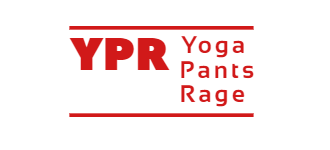If you are just starting out with yoga, some yoga poses might be challenging for you. Yoga blocks can be an incredible tool to help you get the most out of your practice. They can help with alignment, stability, and even relaxation.
In this blog post, we will discuss 12 different ways that you can use yoga blocks to improve your practice.
So, if you are ready to get started, keep reading for 12 awesome ways to use yoga blocks!
Should Beginners Use Yoga Blocks?
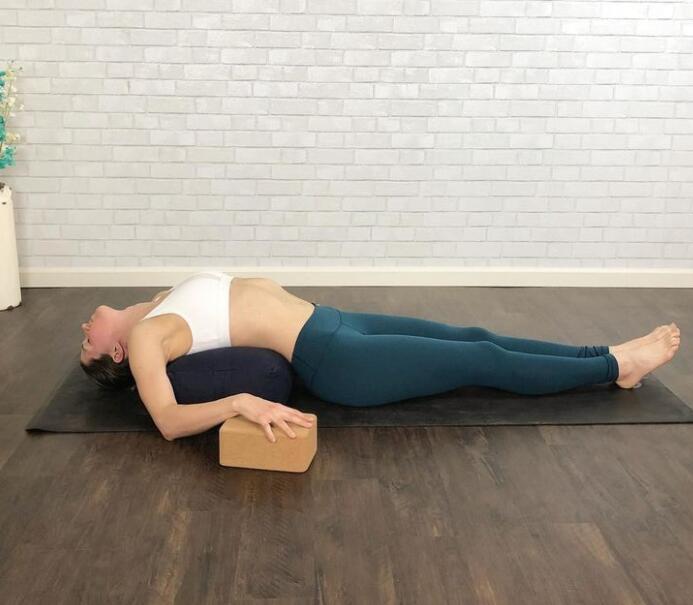
If you are just starting out with yoga, yoga blocks can be absolutely essential to help you understand how your body should move in each pose.
Yoga blocks provide support, stability and even comfort when you need it most. They can also give you more balance and control over the various poses and postures that come with practicing yoga.
Here are the benefit of beginners use yoga blocks
- Offers extra support during poses
- Aids in balance and stability
- Increases the intensity of challenging poses
- Helps create correct alignment & posture
- Provides a boost of height or length when needed
- Improves flexibility and range of motion
- Assists with proper breathing techniques
- Enhances overall yoga practice
- Assists with modified poses for injuries or limitations
- Easily stored and transported
- Increases comfort during poses
- Can be used as props for relaxation & meditation.
Using yoga blocks is a great way to add stability to your practice, making it easier to master the poses as a beginner. Whether you choose foam, cork or wood blocks, they will help you learn how to use your body effectively and safely in all of your poses.
How Can Yoga Blocks Help Yoga Beginners?
You don’t need to be an expert yogi to benefit from yoga blocks. Even if you are starting out, the blocks can help make poses easier and more comfortable for you.
You can use yoga blocks to do the following basic poses:
1. Lotus pose
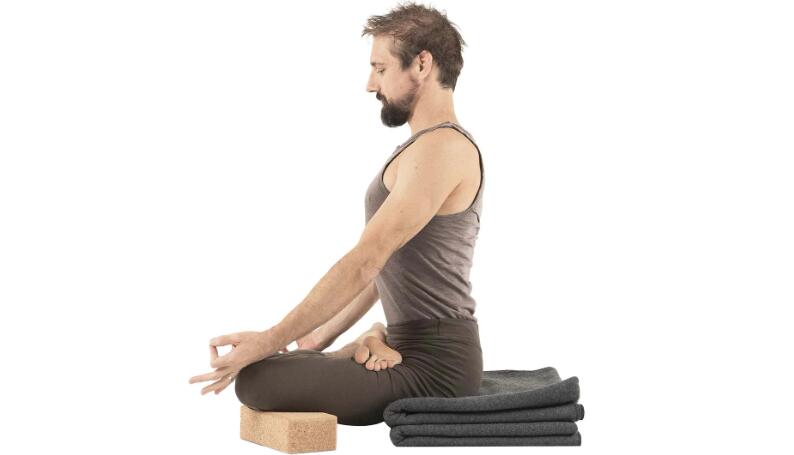
The lotus pose can be challenging for yoga beginners because it requires a lot of flexibility and balance.
In order to do the pose correctly, you need to be able to fold your legs all the way up to your chest and hold them there while you maintain balance. For many beginners, this is a difficult task.
Yoga blocks can help with this by providing support and stability in the pose. They can also help you achieve proper alignment, which is important for preventing injury.
If you are starting out with yoga, practicing the lotus using a yoga block might be a good idea until you have built up enough flexibility and balance.
2. Seated Forward Fold
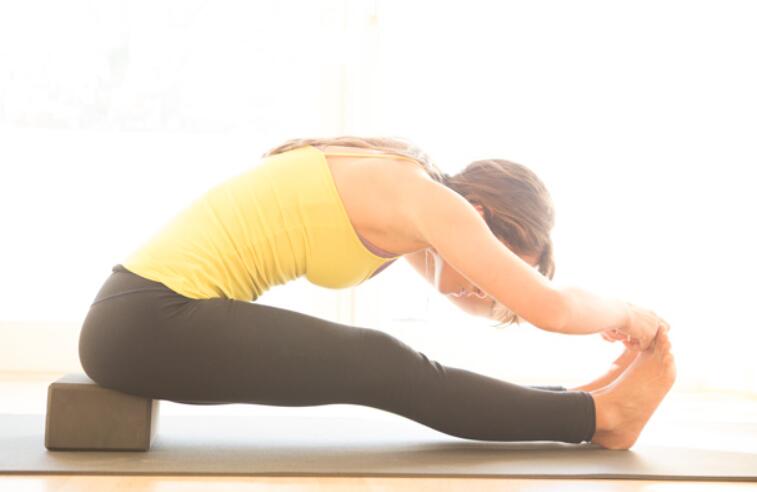
Seated forward fold is a common yoga pose, but it’s often done with poor form.
One mistake is to round the spine and collapse the chest and shoulders. This can lead to pain in the lower back and strains in the shoulders.
A foam yoga block can help beginners to practice this pose with correct form. The block provides support for the lower back, preventing it from rounding.
It also helps to keep the chest and shoulders open, allowing for a deeper stretch in the hamstrings and calves.
With regular practice, using a foam yoga block can help you to achieve better form in seated forward fold and other yoga poses.
3. Extended Side Angle

The Extended Side Angle yoga pose is a great way to stretch and tone your muscles. It’s also a pose that can be modified to suit your level of fitness.
If you’re new to yoga, or if you’re looking for a pose that’s not too challenging, you can use a yoga block to help you complete the Extended Side Angle yoga pose.
To do this, start by standing with your feet hip-width apart. Then, step your right foot out to the side and place your yoga block on the inside of your right foot.
Next, bend your right knee and rest your elbow on your right knee. Reach your left arm up toward the ceiling, then extend it over your head and down toward the floor.
Place your left hand on the yoga block. You should feel a stretch along the left side of your body.
Hold the pose for 30 seconds to 1 minute before returning to standing. Repeat on the other side.
4. Revolved Side Angle
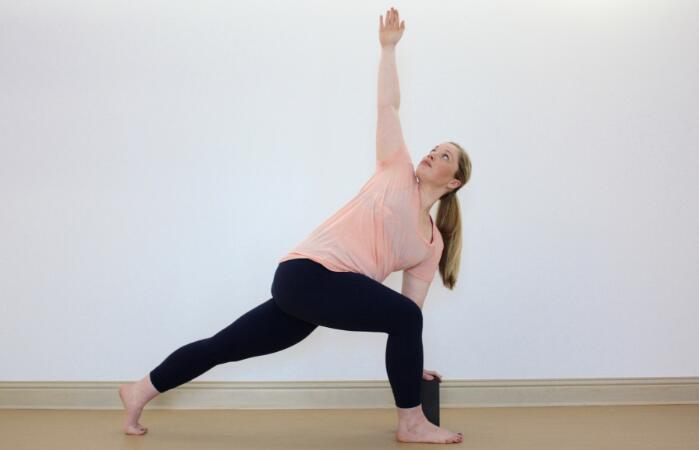
A yoga block can be a helpful tool when doing the Revolved Side Angle yoga pose.
If your hands don’t reach the floor, you can place the yoga block outside your front foot to help you complete the pose. The yoga block will provide support and stability, helping you to get the most out of the pose.
In addition, using a yoga block can help you to maintain good form and alignment. So if you’re looking for a way to take your yoga practice to the next level, consider using a yoga block to do the Revolved Side Angle pose.
5. Triangle Pose
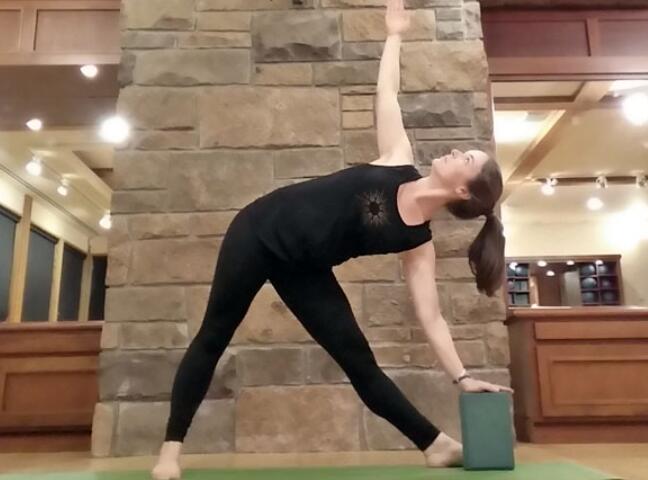
A common mistake people make in the triangle pose is overextending the front knee in an attempt to grab the big toe or place the hand on the mat.
However, it’s important to know that you don’t have to reach your toes in this pose to get a good stretch.
Instead, try placing a yoga block on the inside or outside of your front leg for support. This will help to ensure that you maintain proper alignment while still getting an excellent stretch.
With regular practice, you’ll eventually be able to reach your toes without needing the yoga block. But in the meantime, using a yoga block is a great way to ensure that you get the most out of this pose.
6. Half Moon Pose
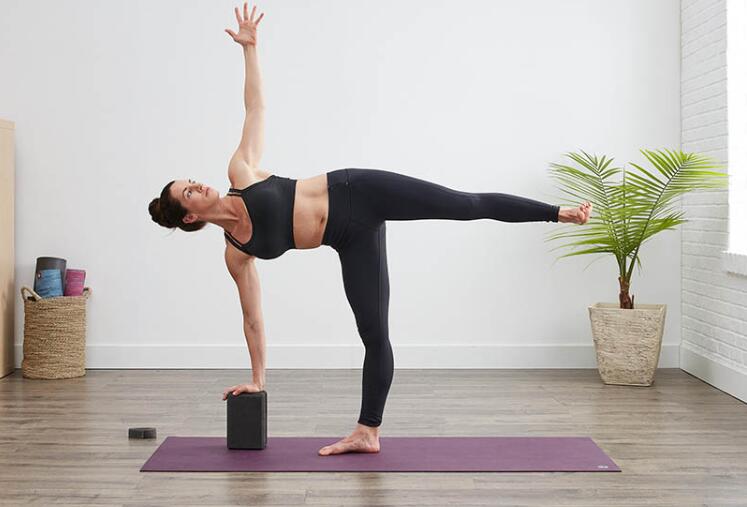
The half moon yoga pose is a challenging balance pose that can be made easier with the use of a yoga block.
To begin, stand with your feet together and your arms at your sides.
Then, raise your right arm and left leg, keeping your torso and hips square.
Next, place the yoga block under your raised hand, and slowly lower your body until your fingertips rests on the block. From here, you can either hold the pose or continue to lower your body until your forearm rests on the block.
If you find it difficult to balance in this position, try placing the yoga block closer to your hand. With practice, you should be able to perform the half moon yoga pose without the need for support.
7. Bridge pose
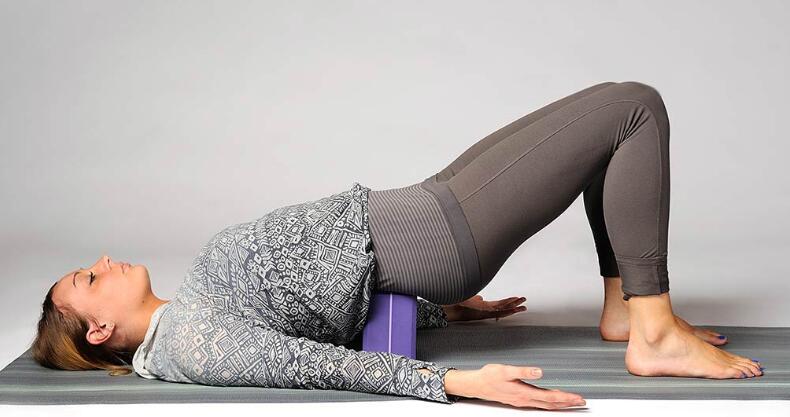
When people do yoga’s bridge pose, they often find that their knees splay open, which can compress the lower back and cause pain.
Placing a yoga block between the legs or under your waist helps to alignment and prevents the knees from splaying open.
As a result, the spine is better supported and the risk of pain is reduced. In addition, yoga blocks can also be used to support the arms in bridge pose, providing even more stability and preventing pain.
8. Reclining Bound Angle Pose
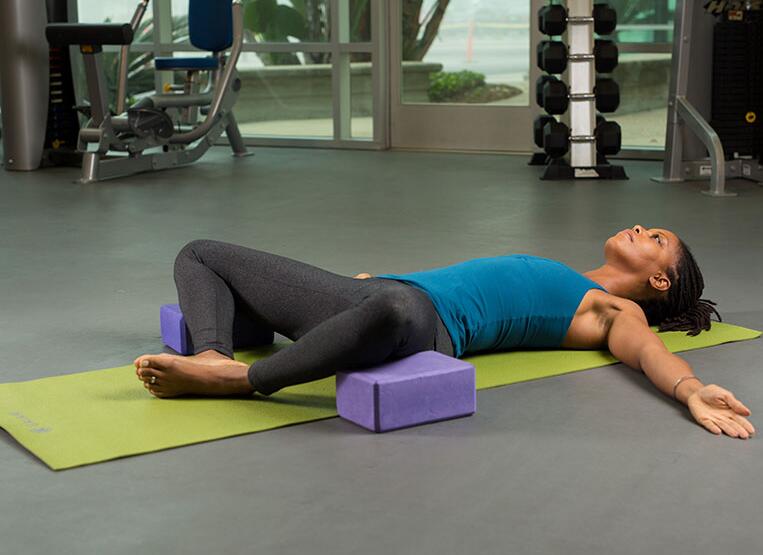
One of the best yoga positions for opening the hips is called supta baddha konasana, or “reclining bound angle pose.”
To get into the position, start by lying on your back with your arms to your sides and the soles of your feet together.
Then, allow your knees to open to the sides and lower towards the floor. For most people, knees will hover above the ground. Take two yoga blocks and place them under the thighs.
The yoga blocks support the knees so the weight of the legs doesn’t pull too hard on the inner thighs. This way inner thighs can relax more and let your hips open more.
If you don’t have yoga blocks, you can use pillows instead. Stay in this position for at least five minutes, or as long as it feels comfortable.
9. Supported Fish Pose
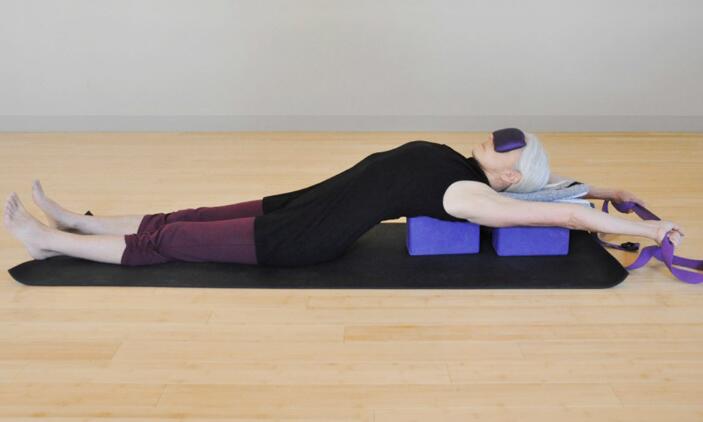
This yoga pose is called Supported Fish Pose. For this pose, you will need a yoga block.
Place one or two yoga blocks directly under your shoulders. You can let your head lay on the mat if your neck feels comfortable.
Otherwise, use another yoga block to support your head. If this feels easy, try placing the yoga block on a higher setting.
Another option is to use the yoga block with the narrow side between your shoulders. This position feels a bit different, so see what works better for you.
10. Viparita Karani(legs up the wall pose)
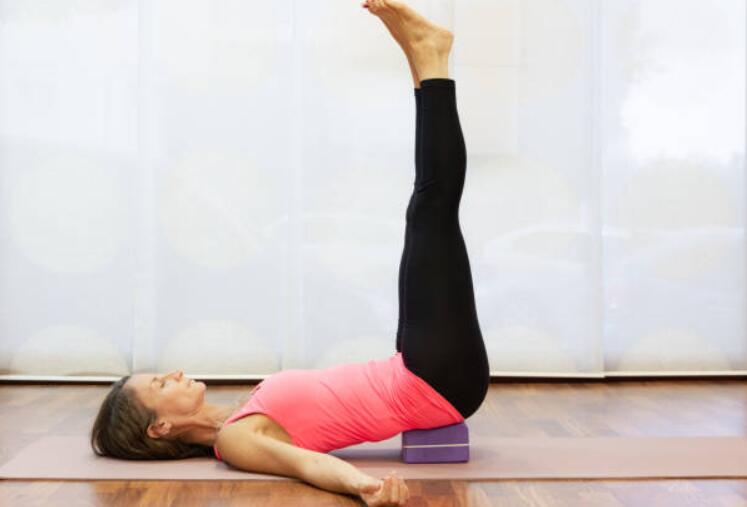
The legs up the wall pose is a yoga pose that is often used to promote relaxation.
The pose can be done with or without a yoga block. If you are using a yoga block, place the block under your sacrum, just like in restorative bridge pose.
Then straighten the legs towards the ceiling and relax here for a few minutes. The legs up the wall pose can also be done without a yoga block by simply placing your legs up against a wall.
Again, relax here for a few minutes and feel the tension melt away from your body.
What Types of Yoga Blocks You Can Choose?
Here are three types of yoga blocks that you can choose from:
- Foam Blocks: These are lightweight and firm, making them perfect for beginner yogis.
- Cork Blocks: These eco-friendly blocks offer a great combination of stability and comfort.
- Wooden Blocks: There are two-inch and three-inch wooden blocks. They are more dense than foam, so they provide stability during poses. (not the best choice for beginners)
Foam yoga blocks:
For any beginner yogi out there, foam blocks are the way to go. They’re lightweight but firm, making them easy to maneuver and adjust as needed. Plus, they offer great support for those learning how to perfect their poses.
In addition, foam blocks provide a boost of height or length when needed. But, foam yoga blocks are not very sturdy, so you won’t be able to rely on them for intense poses or inversions.
As you become more experienced and confident with your poses, you can use the block to make them even more challenging!
Recommendation:

Cork yoga blocks
It is heavier than foam blocks but also nice for beginners because it provides extra stability and support.
The cork blocks are also nice because they are eco-friendly and provide great comfort and security.
These blocks help create balance in your poses, making it easier to learn the correct form. In addition, you can use them to increase the intensity of challenging poses like arm balances or inverted poses.

Wooden yoga blocks
These are denser than foam and cork, providing more stability during poses. If you want to make some of your more advanced poses even more challenging, wooden blocks can help.
They come in two-inch or three-inch thicknesses, depending on how much extra support you need. The wooden blocks can also give you more balance and stability in challenging poses.
However, hooden blocks are heavy and hard and can get slippery if you are sweating, so they are not the best choice for beginners. You can check for bamboo yoga block instead.

Conclusion
Yoga blocks are an excellent tool for helping beginners get into the correct alignment in yoga poses.
They can also be used to add support, stability and comfort during more challenging poses.
There are 10 ways to use yoga blocks for beginners, including bridge pose, half moon pose, reclining bound angle pose, supported fish pose and viparita karani pose.
